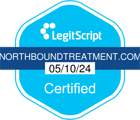Alcoholism affects millions of Americans every year. A large portion of this starts with binge drinking. According to national binge drinking statistics, one in every six U.S. adults binge drinks approximately four times a month. Each time, they consume at least seven drinks, which totals 467 binge drinks per person, and 17 billion total binge drinks consumed annually.
Many who are part of these statistics may not feel like they fall into that data pool. They may think their drinking habits are under control or that there are limited long-term results for a once in a while occurrence. However, we’re delivering 5 facts about binge drinking that may have you rethinking how harmful it truly is.
Fact #1: You May Be Binge Drinking More Than You Think
Binge drinking may conjure up ideas of lining up shots at the bar, all-night partying, or other wild behavior. In many cases, though, binge drinking often appears more subtle than that. Drinking a few beers and taking one shot within a few hours could easily push you to the limit that defines binge drinking.
Binge drinking is recognized as drinking enough alcohol to become intoxicated to a blood alcohol concentration (BAC) level of .08% or above. This is typically reached in men after approximately five drinks and reached in women after approximately four drinks within a span of two hours. Factors like height, weight, and whether you’ve recently eaten all make a difference in how quickly you reach and exceed this level.
A standard drink is identified as 12 ounces of beer, 5 ounces of wine, 1.5 ounces of hard alcohol, and 8 to 9 ounces of malt liquor. Any combination of these can add up quickly, especially if you have a cocktail that’s made exceptionally strong or a craft beer with a higher alcohol percentage to speed up the process. Tracking your drink count becomes increasingly challenging as you continue to drink.
The goal of binge drinking is to become intoxicated as fast as possible versus drinking in moderation socially. This can lead to both several serious side effects that have an immediate impact as well as affect you in the long run.
Fact #2: Binge Drinking Has Short-Term and Long-Term Side Effects
Binge drinking affects your decision-making and judgment abilities, which can lead to risky behavior. It can result in alcohol poisoning and blackouts. These both occur when your body cannot properly metabolize alcohol quickly enough.
Alcohol poisoning affects your breathing, heart rate, and body temperature. In serious cases, it can lead to coma or even death. Additional symptoms may include vomiting, confusion, seizures, and unconsciousness. Blackouts may also occur if you regularly binge drink. This results in being unable to remember certain periods of time after excessive drinking. The likelihood of this happening is heightened when you drink on an empty stomach or cause your BAC level to spike past the .08 limit.
Binge drinking can make you become aggressive, make poor decisions, and cause alcohol-related accidents and injuries. The National Institute on Alcohol Abuse and Alcoholism (NIAAA) reports approximately 88,000 people die from alcohol-related deaths every year. Part of the long-term side effects of binge drinking also includes alcohol dependency.
Frequent, excessive drinking leads to a built-up tolerance in the body. This tolerance requires that you drink more alcohol in order to feel the same pleasant effects as before, during the early stages of intoxication. Eventually, the body becomes dependent on alcohol. It leads to a point where you no longer control when or how much alcohol you drink.
Your brain starts to adapt and changes your brain’s nerve cells and connections. Addiction makes you think you need alcohol in your system to function normally. When you don’t feed the cravings, painful withdrawal symptoms will occur within hours of your last drink. These may include everything from nausea and shakiness to hallucinations and seizures.
Fact #3: Binge Drinking May Lead to Alcohol Use Disorder
An isolated incident of binge drinking is dangerous, although it doesn’t technically constitute an alcohol use disorder. However, people who binge drink are more likely to develop an alcohol use disorder. This occurs when you aren’t able to limit your consumption.
Over 14 million adults, ages 18 and older, reported alcohol use disorder, per a 2018 National Survey on Drug Use and Health. During this time, over 26 percent of people reported they engaged in binge drinking within the past month.
Drinking alcohol affects men and women differently due to how the body is able to metabolize it. When drinking the same amounts, it’s found that women have a higher BAC level.
Per the NIAAA, most age groups see a higher rate of use or dependence on alcohol in men than women. Although, women may be more susceptible to cravings and relapse.
In general, it takes smaller amounts of alcohol for women to become intoxicated than men. The effects of binge drinking and alcohol use disorder are also based on a person’s general health, tolerance, and age, weight, and height.
Fact #4: Binge Drinking Can Be Curbed With Self-Monitoring
One of the most important binge drinking facts is that binge drinking is considered preventable. Prevention requires being able to recognize harmful drinking behaviors and taking action to stop it. To identify how much you drink on a regular basis, keep track of how many days you drink a week or month. Also, maintain a count of how many drinks you consume per outing.
In addition to self-monitoring, set up a specific goal. For example, if you decide to go out for a happy hour or have a drink at home, limit yourself to one or two drinks total. If you find you’re constantly compelled to drink more or don’t feel satisfied with sticking to a limited amount of drinks, it could be indicative of developing alcohol dependence.
If you notice you continue drinking past moderation, switch up your approach. Stick with non-alcoholic beverages when possible and avoid people or situations that tempt or peer pressure you to drink. Or, choose alternative activities that don’t require the presence of alcohol at all. This kind of mindfulness and self-monitoring can prevent this type of drinking behavior from recurring or becoming a bigger problem.
Fact #5: Binge Drinking Is Most Common Among Young Adults
According to binge drinking statistics, binge drinking occurs in nearly every age group, but it’s most common among young adults ages 18-34. However, there’s research that shows people begin drinking as young as the age of 12.
The NIAAA reports that by age 15, nearly 33 percent of teens have had at least one drink and by age 18 that number has increased to 60 percent. Alarmingly, over 90 percent of the alcohol young people consume is in the form of binge drinking.
When this risky behavior starts at such a young age, these habits are carried with them, especially when faced with societal and peer pressure as they enter college and the responsibilities of adulthood. They may feel like the dangers and consequences don’t apply to them as they continue to drink.
Despite the prevalence among a younger age demographic, binge drinking can and does affect all ages. Identifying dangerous drinking patterns from the beginning may prevent the cycle of addiction from occurring. It’s important to remember that not everyone reacts to drinking alcohol in the same way. Some people can easily engage in moderation, while others have a higher susceptibility to addiction tendencies.
Benefiting From Alcohol Treatment
Problems with alcohol can range from mild to severe, but at any level, addiction treatment can be beneficial. For some, binge drinking may be temporary. It may not lead down a road of alcohol addiction, but the risk is there. Before binge drinking turns into alcohol dependency or addiction, treatment is a way to explore ways to monitor and reduce the amount of alcohol consumed. It can also provide alternative ways to focus on avoiding drinking altogether.
When self-monitoring doesn’t work and the urge to drink is ever-present, that’s a sign of alcohol addiction. If the problem has grown to a place where you’re unable to control how much you drink and/or it’s caused negative effects within your environment, seeking treatment from a medically managed program is a beneficial solution. Since alcohol addiction affects you on all levels – physically, mentally, and emotionally – it’s crucial that the care provided is approached with this in mind.
Additionally, it’s safer to detox under the supervision of medical professionals who can help you manage your withdrawal symptoms and maintain your physical stability. It’s also helpful to have the emotional support to motivate you to continue with treatment during the most challenging times. As you progress through a detox program, different therapies and techniques will uncover the causes of your addiction.
There is always help available that is customized to what you need to overcome alcohol addiction and heal. Whether it’s short-term counseling or long-term recovery and treatment, it can improve and preserve your health and well-being. Your care team will work with you to form new strategies and alternatives to maintain a sober living.
Sources:
- “Alcohol Facts and Statistics.” Nih.gov. N.p., 25 Apr. 2019., https://www.niaaa.nih.gov/publications/brochures-and-fact-sheets/alcohol-facts-and-statistics
- “Alcohol Poisoning – Symptoms and Causes – Mayo Clinic.” Mayoclinic.org. N.p., 19 Jan. 2018., https://www.mayoclinic.org/diseases-conditions/alcohol-poisoning/symptoms-causes/syc-20354386?page=0&citems=10
- Vandergriendt, Carly. “30 Facts about Alcohol, plus 5 Myths: Statistics and More.” Healthline.com. N.p., 16 Apr. 2018., https://www.healthline.com/health/facts-about-alcohol#facts
- National Institute on Drug Abuse. “Sex and Gender Differences in Substance Use | National Institute on Drug Abuse.” Drugabuse.gov. N.p., n.d., https://www.drugabuse.gov/publications/research-reports/substance-use-in-women/sex-gender-differences-in-substance-use
Author
-

President, CEO & Founder at Northbound Treatment Network
Paul Alexander is the CEO, President & Founder of Northbound Treatment Network in Newport Beach, California. He believes wholeheartedly in transformational leadership, organizational health and effective, fully integrated substance use disorder and mental health treatment. With over 27 years of experience in behavioral healthcare, Paul has extensive knowledge of “in vivo” treatment modalities, clinical development, operations, strategy, marketing and financial planning. He has been widely recognized for his development of collegiate-based residential treatment programs for students in recovery and authored a research study at The University of California confirming this modality’s effectiveness.
Paul’s comprehensive professional experience, willingness to innovate, and emphasis on organizational health are vital factors in Northbound’s continued success. Paul received his Certified Addiction Treatment Specialist training at Saddleback College in Mission Viejo, CA, and was awarded Outstanding Alumni Service Award in 2002. Paul holds a Bachelor of Arts degree in Criminology, Law and Society, Summa Cum Laude, from University of California, Irvine, and a Juris Doctorate degree from Loyola Law School of Los Angeles. Paul currently serves on The National Association of Addiction Treatment Providers (NAATP) board. In addition, he serves on The Family Recovery Foundation board and The CarePossible board in Orange County; both organizations are committed to raising funds for family recovery and treatment for former military personnel. Paul is in recovery himself and lives in Orange County with his wife Silvana and his two young sons, Noah and Dean.










